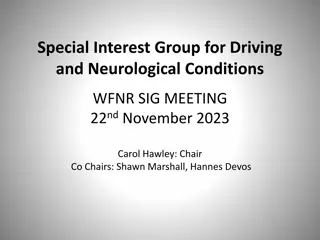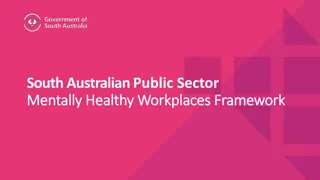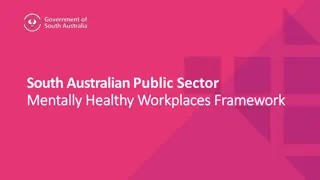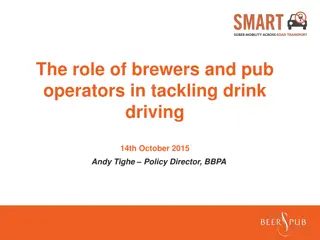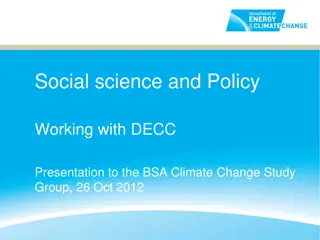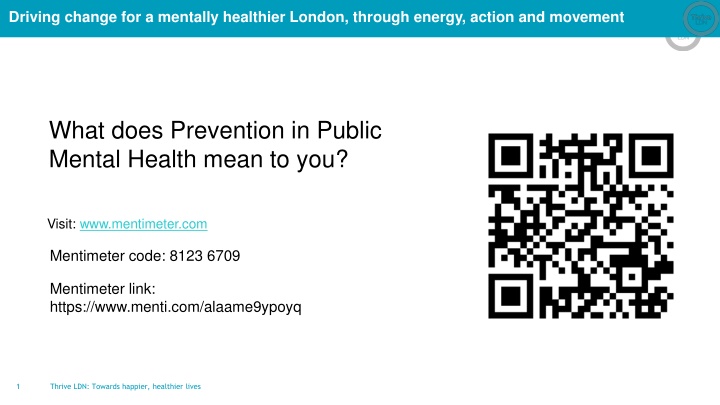
Driving Change for a Mentally Healthier London through Energy, Action, and Movement
Creating a mentally healthier London through prevention in public mental health, strategic frameworks, leadership, and integrated enablers. Implementing direct actions to address climate, environment, and mental health intersections.
Download Presentation

Please find below an Image/Link to download the presentation.
The content on the website is provided AS IS for your information and personal use only. It may not be sold, licensed, or shared on other websites without obtaining consent from the author. If you encounter any issues during the download, it is possible that the publisher has removed the file from their server.
You are allowed to download the files provided on this website for personal or commercial use, subject to the condition that they are used lawfully. All files are the property of their respective owners.
The content on the website is provided AS IS for your information and personal use only. It may not be sold, licensed, or shared on other websites without obtaining consent from the author.
E N D
Presentation Transcript
Driving change for a mentally healthier London, through energy, action and movement What does Prevention in Public Mental Health mean to you? Visit: www.mentimeter.com Mentimeter code: 8123 6709 Mentimeter link: https://www.menti.com/alaame9ypoyq 1 Thrive LDN: Towards happier, healthier lives
Driving change for a mentally healthier London, through energy, action and movement Compass Points Reflection E = Excitements What excites you about Communities of Practice ? What s the upside? W= Worries What do you find worrisome about this approach? What s the downside? N = Needs What do you need to know / find out about this approach? S = Suggestions What suggestions for the programme do you have at this point? 2 Thrive LDN: Towards happier, healthier lives
Driving change for a mentally healthier London, through energy, action and movement Driving change for future generations of Londoners Integrated enablers Strategic factors and frameworks Leadership: Inspire action towards improving the conditions of society to prevent poor mental health. Governance: Strengthen public mental health partnerships Mental Health in all Policies: Working across national, regional and sub-regional departments to embed mental health in all priority areas. Analytic tools Data and monitoring: Identify regional and sub-regional data sources. Equity impact assessment: Ensure all activities undergo equity impact assessments. Pragmatic intelligence Assets and needs assessment: A pragmatic assessment of London s public mental health assets and needs. Best practice: Develop networks and mechanisms to share examples. Utilities Digital technology: Utilise digital technology opportunities. Communications: Continue to coordinate and scale up public mental health campaigns. Anchors and paths: Explore opportunities for anchor institutions in London to integrate mental health considerations. Resource: Work with philanthropy to develop an accelerator fund. 3 Thrive LDN: Towards happier, healthier lives
Driving change for a mentally healthier London, through energy, action and movement Direct action 1: Climate, environment, and mental health Research and interventions tackling the intersection between climate, environment and mental health are still emerging, but we know that the mental health harms of climate change are not inevitable: individual-level, community-level, and systems-level resources can be made available to support individuals be resilient in the face of the geophysical impacts of climate change. Options System Establish a Climate, Environment and Mental Health Action Forum to bring together multi-agency statutory partners, VCSE organisations and community groups. Establish a Mental Health and Climate Concordat. Integrate mental health considerations within wider climate and nature action to build psychological resilience and programmes within wider activities. Extend public mental health and crisis response and recovery to mental health impacts of climate events. Support and promote initiatives like the Centre for Sustainable Healthcare s 'Green Space for Health' Program and the NHS Forest initiative, aiming to plant more trees on London s NHS sites. Build academic partnerships to conduct democratised, participatory, interdisciplinary research and evaluation to build the evidence-base on impacts and interventions Communities Work with philanthropy to explore innovative funding models to develop, test and evaluate climate, nature and mental health projects. Work to expand green social prescribing initiatives focussing on mental health. Work with gardening groups to trial gardening-based mental health projects Individuals Develop awareness raising campaigns Training opportunities for frontline workers and Londoners to develop psychological resilience knowledge, awareness, and skills. Develop behavioural changes campaigns that establish links between mental health and climate action. 4 Thrive LDN: Towards happier, healthier lives
Driving change for a mentally healthier London, through energy, action and movement Direct action 2: Young Londoners mental health The mental health of children and young people remain a priority across London and align with existing commitments at sub-regional and local levels. A children and young people s focus is supported both by the available evidence in mental health, given that for mental health childhood is the most impactful time for interventions, and second, it s a focus which would align with existing priorities across London. Options System Professional mental health support in secondary schools and an out of school open-access mental health hub for children and young people in every community. Targeted, integrated mental health and financial support to disadvantaged families. Communities Support families to have conversations about mental health and wellbeing. School-based interventions that support building resilience and good mental health in children and young people. School-based interventions based on trauma-informed practice for young people and staff given the multiple current challenges experienced by children and young people. Interventions that support creative health outlets. Individuals Digital interventions that support the mental health and wellbeing of children and young people. Targeted work with older younger people (16-24) and young women within this age group who have a higher incidence of poor mental health. 5 Thrive LDN: Towards happier, healthier lives
Driving change for a mentally healthier London, through energy, action and movement Direct action 3: Physical and mental health People with long-term physical conditions commonly experience poor mental health. They are more likely to experience anxiety and depression which lead to worse outcomes in managing chronic conditions due to the comorbidity with mental health. Options System Further integrate mental and physical health at the clinical level through co-ordinating clinical support across primary, community and secondary care. Build cross-sector relationships with sports, leisure, fitness, and wellness industries Develop a workforce that is skilled with an understanding of the interconnectedness between mental and physical health. Communities Explore the role of social prescribing as a link to opportunities for managing health and wellbeing. Cultivate relationships with local fitness, leisure, sports, and wellness spaces. Nurture an awareness of affordable and/ or free local community networks based on physical activity. Individuals A focused, multi-channel campaign and conversation to raise awareness of the link between mental and physical health. Support people to manage their own health through health promotion. Promote physical activity and movement as a protective factor for overall health. 6 Thrive LDN: Towards happier, healthier lives
Driving change for a mentally healthier London, through energy, action and movement Direct action 4: Suicide and self-harm reduction for young Londoners Suicide is the main cause of death in young people under the age of 35 in the UK.xlvWhile the suicide rate in under-20s is relatively low compared with older age groups, rates across all age groups under 25 have been increasing over the last decade in England.xlvi Additionally self-harm rates have also been rising in children and young peoplexlviii The rate of maternal death in the UK has risen by 15% in 10 years xlix. Suicide makes up the leading direct cause of death for new mothers up to the first 12 months post-birthl. Options System Promote online safety to reduce harms and improve support and signposting. Provide effective bereavement support to children and young people impacted by suicide. Expand maternal mental health services Targeted interventions including parenting programmes. Communities Support universities to embed itsSuicide-safer universitiesguidance. Deliver further school-based awareness programmes. Work with grassroot organisations and services which support young autistic Londoners, young LGBTQ+ Londoner s, young people who have self-harmed, young people who are in contact with mental health services, young people who are people in contact with the justice system and pregnant women and new parents. Individuals Promote Zero Suicide Alliances university student training. Access to joint financial and wellbeing services. 7 Thrive LDN: Towards happier, healthier lives







